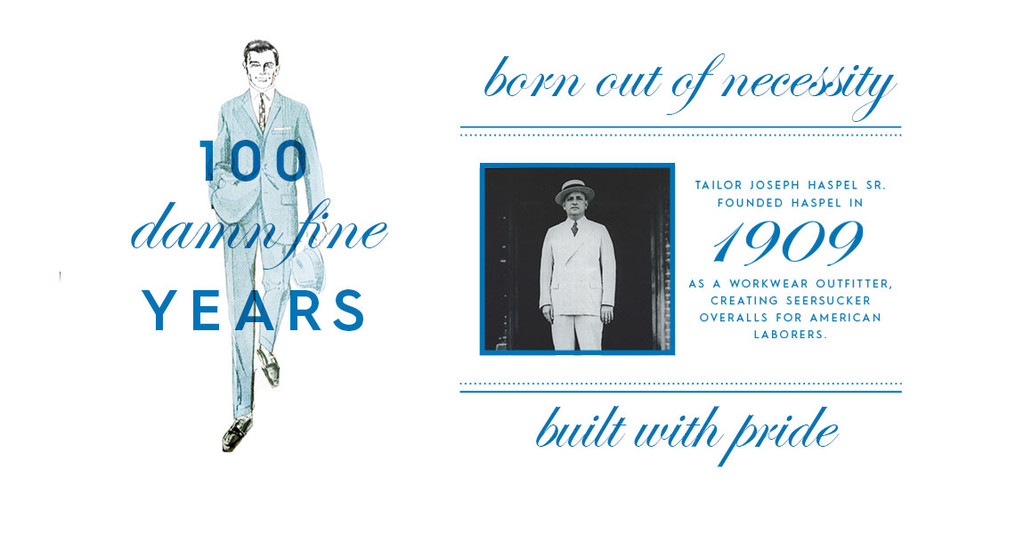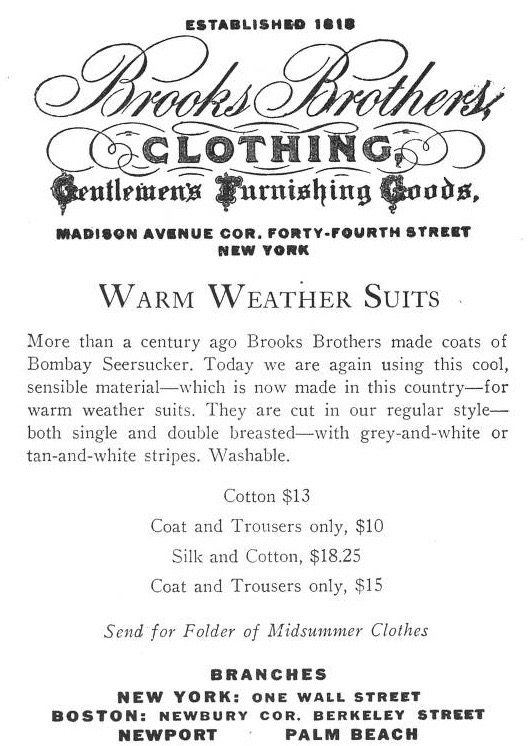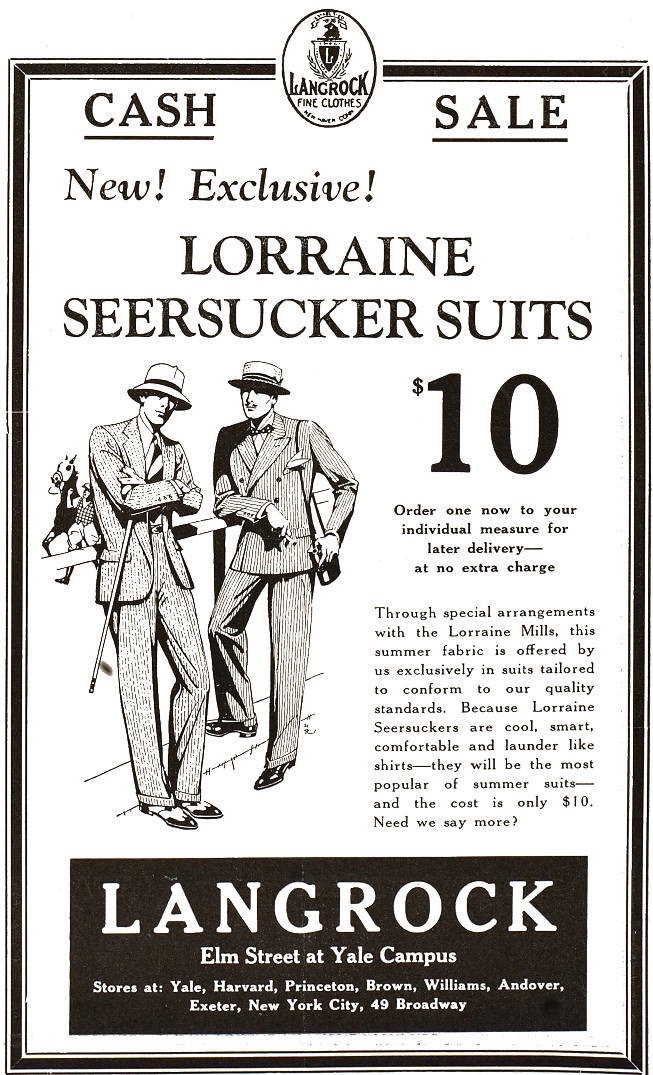Today is National Seersucker Day, which grew out of Seersucker Thursday on Capitol Hill. But while the day’s origins are clear, the beginnings of the fabric itself are somewhat contested. Both Haspel in New Orleans and Brooks Brothers in New York claim to have either introduced or popularized seersucker.
This is from Haspel’s website:
 On the contrary, an article on Brooks Brothers’ history at Gentleman’s Gazette claims that Brooks introduced seersucker in 1870, though it does not provide a citation.
On the contrary, an article on Brooks Brothers’ history at Gentleman’s Gazette claims that Brooks introduced seersucker in 1870, though it does not provide a citation.
This CNN article from 2013 has spokespersons from both Brooks and Haspel plead their cases:
Seersucker is one of a handful of fabrics — like denim and jersey — that has cultivated a distinctly American identity. Even though the fabric has ancient roots in Persia and India — its name derived from a phrase that translates as “milk and sugar” — it has been used to outfit men (and women) up and down the U.S. East and Gulf coasts for more than a century, according to Brooks Brothers’ in-house historian, Kelly Nickel.
In America, seersucker started out as a blue-collar fabric, used by service staff and factory workers to cope with soaring temperatures in and out of pre-air conditioned buildings. But an interesting social phenomenon happened in the 1920s, thanks to the advent of the seersucker suit, as popularized by Ivy Leaguers and high society men outfitted in Haspel and Brooks Brothers.
Haspel of New Orleans lays a claim to originating the seersucker suit, circa 1909. Joseph Haspel had a business producing seersucker overalls for Louisiana factory workers at the turn of the 20th century, when he put his sewing skills into a practical and stylish suit. In a flamboyant sales pitch, Haspel wore his seersucker suit to the beach, jumped into the ocean and was dry by dinner, said his great granddaughter and current president of the company Laurie Aronson.
“We’re the originators, not the imitators,” she said. “Haspel still does it best.”
Brooks Brothers started selling seersucker suits in the 1920s, said Nickel. While the origin of the seersucker suit may lay with Haspel, Brooks Brothers is the one who popularized it, she said.
What exactly happened in the ’10s and ’20s is harder to pin down. What is clearer is that by the 1930s the fabric was in full swing. The following is an ad Brooks Brothers took out in the Yale Daily News in 1932:
This ad, also from 1932, shows that the other Ivy League clothiers were also offering the fabric:
I reached out to Bruce Boyer, who said, “They might both be right. Haspel may have been the ‘originator,’ but Brooks may have introduced the fabric to the Eastern Establishment. In the ‘Esquire Encyclopedia,’ it’s mentioned that writer Damon Runyon rather introduced the seersucker suit to New York.”
I like the idea that each did its part to popuarlize the fabric, which eventually went nationwide. And that’s why it’s called National Seersucker Day. It’s nice to see the country come together once in a while. — CHRISTIAN CHENSVOLD
Top image via Regattas & Repp Ties













The derivation of “seersucker” from a Farsi/Hindi expression (shir-o-shakkar) meaning “milk-and-sugar” is given as the etymology by all dictionaries, with an explanation that the Indians likened the flat colored stripes to milk and the puckered white stripes to sugar because of the texture.
I wish I could understand the resemblance of colored stripes to milk. Perhaps the alternating smooth and puckered stripes were in fact both white in the original seersucker cloth. Then, the name would make sense to me.
Does anybody know if this was the case?
As is the case on many, if not most days between Memorial Day and Labor Day, I am wearing seersucker. Today’s suit is from Polo in tan and white stripes, with a white pinpoint shirt with a pinned collar and a madras tie. While I had intended only to be comfortable on a potentially muggy day, it turns out that I am actually commemorating a national holiday. I feel downright patriotic.
I have a gray seersucker suit, and always thought I was being nouveau. Based on the BB ad above, apparently blue and white is the upstart!
Also, the Langrock ad took me back. I was familiar with their Princeton store, and had no idea it had other locations! RIP.
Supposedly the milk refers to white, and the sugar referred originally to brown stripes rather than blue. Who knows, history is murky, but the weather is clear, and seersucker season is in swing.
I’ve never owned a seersucker suit. Back in the late 70’s, early 80’s, I wore seersucker slacks for golf, and with a navy blazer and tie for dressier occasions.
JosABank has sales where I’ve seen seersucker suits for around $100. I’ve been tempted to buy one a few times.
An elderly gentleman I knew was buried in a blue and white suit, pink shirt, and a plaid tie. Looked very dapper in the casket. All dressed up and no where to go.
Cheers!
Conversely|
Dressed for the eternity!
P.S.
Those 10 dollars suits of 1932..all cavanassed,no glue,no polyester..Today the price (also correct with inflation rate) would be very,very more high!
I enjoy poplin and linen in the Texas heat, but seersucker is my favorite in the summer. It seems to circulate air better than the other fabrics and elicits more positive comments from women (and I am sure some disparaging comments from some of my colleagues.
I am a docent at a Frank Lloyd-Wright villa located in Geneva, IL. The original owner of that home, Col. George Fabyan, was the scion of the family that made seersucker popular in America in the early 20th century. The company was Bliss-Fabyan, in Boston, and their cloth was called “Ripplette”. The cloth made them a huge fortune because it required little, if any, pressing; and women found it ideal for home-sewing. Col. Fabyan came to Chicago to be an agent for the company’s growth into the mid west. It would be interesting to research the use of their product in the men’s apparel industry. Unfortunately we do not have access to that information at our museum.
“My epiphany is that seersucker has become my sauterne, with a memory in every wrinkle” remains one among the all time great lines about clothing.
I’ll give this one a try:
Among twenty tropical worsteds
the only wrinkly thing
was the lapel of a seersucker.
(inspiration: Wallace Stevens)
I’d heard the Haspel “jumped in the water and dry by dinner” story, but it was applied to their pincord cloth, Rayon I think. Wore an LLBean seersucker shirt today, though I forgot it was the Holiday.
I love wearing seersucker. I was in Baton Rouge Spring 2015 and did my best to get to a Haspel location, but it did not work out. I wanted to see if there was a quality difference in the product they have to offer. My seersucker items are from a variety of companies.
I would be interested to know what ocean and what beach Mr. Haspel took his dip in. The beaches of the Gulf of Mexico are loved by its locals, however the sand is imported and the water is brown. That would be one very dirty man with a rank odor.
@carmello
In 1932 a US$10.00 gold coin had slightly less than 1/2 oz of gold in it. The price of the $10.00 1932 suit is equivalent to approximately US$620.00 today.
DCG has it right with regard to the name. The “sugar” refers to a brown color (sugar as something white is a very modern phenomenon). You can still get a seersucker in brown and white stripes – a very nice variant. And as the BB add above indicates, tan-and-white was an option in the ’30s, while blue was not.
@Roger C. Russel II
In the version I recall, he went into Lake Ponchartrain
Remember when buying seersucker, the more pucker in the fabric the better. Beware of the imposter striped fabric without the…pucker!
According to the article below from 1977, Jos. Haspel, Sr. wore a seersucker suit of Orlon and cotton into the Atlantic at Boca Raton in 1947 to demonstrate the quick-drying, non-wrinkling attributes of the new synthetic “miracle fiber.” The story was related by his son, Joseph Jr. The article also includes some interesting observations from George Frazier, as well as a mention of Brooks’ role in promoting the fabric in the north. This seems to have the ring of authenticity about it, since the ocean plunge would make more sense in a suit made from a synthetic blend than it would in all cotton which requires pressing, but perhaps it was a repeat of an earlier stunt performed in New Orleans.
https://news.google.com/newspapers?nid=1499&dat=19770811&id=GFwaAAAAIBAJ&sjid=eSkEAAAAIBAJ&pg=6918,155805&hl=en
I had read somewhere (maybe in one of Messrs. Boyer or Flusser’s books) that Damon Runyon was a big fan of seersucker and that it puzzled New Yorkers that he wore suits in the wrinkly, light-colored fabric. There is corroboration of that in this NY Times article form 10 years back:
http://www.nytimes.com/2006/04/20/fashion/thursdaystyles/20CODES.html?_r=2& .
I have been a big fan of seersucker since I was in my 20s, and still tend to get complements from strangers, particularly from women, when I wear it, particularly in Manhattan where it is not as common as it is down south, but also in New Orleans, Washington, Charleston and Virginia. Mine are all cotton, and come from Brooks, Press, Polo and Haspel. I think the ones from J. Press are my favorites (one blue and one gray), but the ones at O’Connell’s look good on line and should be guaranteed to be Ivy correct.
@SE thanks for the kind words.
To all those interested in the sea plunge we covered it here http://www.ivy-style.com/bathing-suit-joseph-haspel-goes-swimming-in-seersucker-1946.html
There is certainly some debate about fabric and some details but was surprised when I saw pictures from the event.
I have a pair of seersucker shorts which are absolutely amazing. The fabric is definitely lighter than the usual cotton and they dry quickly. I was wearing my pair at Mt. Rushmore on a cross-country family trip when it rained.- the shorts made my bottom & thighs happy.
Damon Runyon born in Manhattan, Kansas, once home and headquarters of the collegiate (ivy) Woody’s men’s shops. He seems to have worked in Kansas and Colorado prior to NY.
Have lots of seersucker, got married in a three piece seersucker suit in 1975, got a divorce in a Polo seersucker jacket in 1995, probably be buried in it.